Comparative Study of the Impacts of Maize and Soybean on Soil and Water Conservation Benefits during Different Growth Stages in the Loess Plateau Region
Abstract
:1. Introduction
2. Materials and Methods
2.1. Study Site
2.2. Experimental Setup and Materials
2.3. Experimental Design
2.4. Parameter Measurements and Calculations
2.5. Statistical Analysis
3. Results
3.1. Runoff Generation and Sediment Yield
3.2. Soil and Water Conservation Benefits
3.3. Changes of Soil and Water Conservation Benefits
4. Discussion
4.1. Effects of Maize and Soybean in Regulating Runoff and Sediment
4.2. Factors Affecting the Performance of Maize and Soybean in Conserving Soil and Water
4.3. Crop Selection for Soil and Water Conservation
4.4. Future Studies
5. Conclusions
Author Contributions
Funding
Data Availability Statement
Acknowledgments
Conflicts of Interest
References
- Cerdà, A.; Flanagan, D.C.; le Bissonnais, Y.; Boardman, J. Soil Erosion and Agriculture. Soil Tillage Res. 2009, 106, 107–108. [Google Scholar] [CrossRef]
- Chen, J.; Xiao, H.; Li, Z.; Liu, C.; Wang, D.; Wang, L.; Tang, C. Threshold Effects of Vegetation Coverage on Soil Erosion Control in Small Watersheds of the Red Soil Hilly Region in China. Ecol. Eng. 2019, 132, 109–114. [Google Scholar] [CrossRef]
- Prosdocimi, M.; Cerdà, A.; Tarolli, P. Soil Water Erosion on Mediterranean Vineyards: A Review. Catena 2016, 141, 1–21. [Google Scholar] [CrossRef]
- Espigares, T.; Moreno-de las Heras, M.; Nicolau, J.M. Performance of Vegetation in Reclaimed Slopes Affected by Soil Erosion. Restor. Ecol. 2011, 19, 35–44. [Google Scholar] [CrossRef]
- Liu, X.; Zhang, S.; Zhang, X.; Ding, G.; Cruse, R.M. Soil Erosion Control Practices in Northeast China: A Mini-Review. Soil Tillage Res. 2011, 117, 44–48. [Google Scholar] [CrossRef]
- Rodrigo Comino, J.; Quiquerez, A.; Follain, S.; Raclot, D.; Le Bissonnais, Y.; Casalí, J.; Giménez, R.; Cerdà, A.; Keesstra, S.D.; Brevik, E.C.; et al. Soil Erosion in Sloping Vineyards Assessed by Using Botanical Indicators and Sediment Collectors in the Ruwer-Mosel Valley. Agric. Ecosyst. Environ. 2016, 233, 158–170. [Google Scholar] [CrossRef]
- Chalise, D.; Kumar, L.; Kristiansen, P. Land Degradation by Soil Erosion in Nepal: A Review. Soil Syst. 2019, 3, 12. [Google Scholar] [CrossRef]
- Lal, R. Soil Degradation by Erosion. Land Degrad. Dev. 2001, 12, 519–539. [Google Scholar] [CrossRef]
- Rutebuka, J.; Kagabo, D.M.; Verdoodt, A. Farmers’ Diagnosis of Current Soil Erosion Status and Control within Two Contrasting Agro-Ecological Zones of Rwanda. Agric. Ecosyst. Environ. 2019, 278, 81–95. [Google Scholar] [CrossRef]
- Wang, Z.; Chen, Z.; Yu, S.; Zhang, Q.; Wang, Y.; Hao, J. Erosion-Control Mechanism of Sediment Check Dams on the Loess Plateau. Int. J. Sediment Res. 2021, 36, 668–677. [Google Scholar] [CrossRef]
- Zhou, D.; Zhao, S.; Zhu, C. The Grain for Green Project Induced Land Cover Change in the Loess Plateau: A Case Study with Ansai County, Shanxi Province, China. Ecol. Indic. 2012, 23, 88–94. [Google Scholar] [CrossRef]
- Deng, L.; Kim, D.-G.; Li, M.; Huang, C.; Liu, Q.; Cheng, M.; Shangguan, Z.; Peng, C. Land-Use Changes Driven by ‘Grain for Green’ Program Reduced Carbon Loss Induced by Soil Erosion on the Loess Plateau of China. Glob. Planet. Chang. 2019, 177, 101–115. [Google Scholar] [CrossRef]
- Chen, Y.; Wang, K.; Lin, Y.; Shi, W.; Song, Y.; He, X. Balancing Green and Grain Trade. Nat. Geosci. 2015, 8, 739–741. [Google Scholar] [CrossRef]
- He, L.; Guo, J.; Zhang, X.; Liu, B.; Guzmán, G.; Gómeza, J.A. Vegetation Restoration Dominated the Attenuated Soil Loss Rate on the Loess Plateau, China over the Last 50 Years. Catena 2023, 228, 107149. [Google Scholar] [CrossRef]
- Wang, X.; Wang, B.; Xu, X.; Liu, T.; Duan, Y.; Zhao, Y. Spatial and Temporal Variations in Surface Soil Moisture and Vegetation Cover in the Loess Plateau from 2000 to 2015. Ecol. Indic. 2018, 95, 320–330. [Google Scholar] [CrossRef]
- Durán Zuazo, V.H.; Rodríguez Pleguezuelo, C.R. Soil-Erosion and Runoff Prevention by Plant Covers. A Review. Agron. Sustain. Dev. 2008, 28, 65–86. [Google Scholar] [CrossRef]
- Lacombe, G.; Valentin, C.; Sounyafong, P.; de Rouw, A.; Soulileuth, B.; Silvera, N.; Pierret, A.; Sengtaheuanghoung, O.; Ribolzi, O. Linking Crop Structure, Throughfall, Soil Surface Conditions, Runoff and Soil Detachment: 10 Land Uses Analyzed in Northern Laos. Sci. Total Environ. 2018, 616–617, 1330–1338. [Google Scholar] [CrossRef] [PubMed]
- Zheng, J.; Fan, J.; Zhang, F.; Yan, S.; Xiang, Y. Rainfall Partitioning into Throughfall, Stemflow and Interception Loss by Maize Canopy on the Semi-Arid Loess Plateau of China. Agric. Water Manag. 2018, 195, 25–36. [Google Scholar] [CrossRef]
- Sun, J.; Yu, X.; Li, H.; Chang, Y.; Wang, H.; Tu, Z.; Liang, H. Simulated Erosion Using Soils from Vegetated Slopes in the Jiufeng Mountains, China. Catena 2016, 136, 128–134. [Google Scholar] [CrossRef]
- Wells, T.; Hancock, G.R.; Martinez, C.; Dever, C.; Kunkel, V.; Gibson, A. Differences in Soil Organic Carbon and Soil Erosion for Native Pasture and Minimum till Agricultural Management Systems. Sci. Total Environ. 2019, 666, 618–630. [Google Scholar] [CrossRef]
- Zhang, B.; Zhang, G.; Zhu, P.; Yang, H. Temporal Variations in Soil Erodibility Indicators of Vegetation-Restored Steep Gully Slopes on the Loess Plateau of China. Agric. Ecosyst. Environ. 2019, 286, 106661. [Google Scholar] [CrossRef]
- De Baets, S.; Poesen, J.; Knapen, A.; Barberá, G.G.; Navarro, J.A. Root Characteristics of Representative Mediterranean Plant Species and Their Erosion-Reducing Potential during Concentrated Runoff. Plant Soil 2007, 294, 169–183. [Google Scholar] [CrossRef]
- Vannoppen, W.; Vanmaercke, M.; De Baets, S.; Poesen, J. A Review of the Mechanical Effects of Plant Roots on Concentrated Flow Erosion Rates. Earth-Sci. Rev. 2015, 150, 666–678. [Google Scholar] [CrossRef]
- Arnhold, S.; Lindner, S.; Lee, B.; Martin, E.; Kettering, J.; Nguyen, T.T.; Koellner, T.; Ok, Y.S.; Huwe, B. Conventional and Organic Farming: Soil Erosion and Conservation Potential for Row Crop Cultivation. Geoderma 2014, 219–220, 89–105. [Google Scholar] [CrossRef]
- El Kateb, H.; Zhang, H.; Zhang, P.; Mosandl, R. Soil Erosion and Surface Runoff on Different Vegetation Covers and Slope Gradients: A Field Experiment in Southern Shaanxi Province, China. Catena 2013, 105, 1–10. [Google Scholar] [CrossRef]
- Alliaume, F.; Rossing, W.A.H.; Tittonell, P.; Jorge, G.; Dogliotti, S. Reduced Tillage and Cover Crops Improve Water Capture and Reduce Erosion of Fine Textured Soils in Raised Bed Tomato Systems. Agric. Ecosyst. Environ. 2014, 183, 127–137. [Google Scholar] [CrossRef]
- Chen, Z.; Wang, L.; Wei, A.; Gao, J.; Lu, Y.; Zhou, J. Land-Use Change from Arable Lands to Orchards Reduced Soil Erosion and Increased Nutrient Loss in a Small Catchment. Sci. Total Environ. 2019, 648, 1097–1104. [Google Scholar] [CrossRef]
- Rong, L.; Duan, X.; Zhang, G.; Gu, Z.; Feng, D. Impacts of Tillage Practices on Ephemeral Gully Erosion in a Dry-Hot Valley Region in Southwestern China. Soil Tillage Res. 2019, 187, 72–84. [Google Scholar] [CrossRef]
- Zhao, X.; Huang, J.; Wu, P.; Gao, X. The Dynamic Effects of Pastures and Crop on Runoff and Sediments Reduction at Loess Slopes under Simulated Rainfall Conditions. Catena 2014, 119, 1–7. [Google Scholar] [CrossRef]
- Lin, Q.; Xu, Q.; Wu, F.; Li, T. Effects of Wheat in Regulating Runoff and Sediment on Different Slope Gradients and under Different Rainfall Intensities. Catena 2019, 183, 104196. [Google Scholar] [CrossRef]
- Sharma, N.K.; Singh, R.J.; Mandal, D.; Kumar, A.; Alam, N.M.; Keesstra, S. Increasing Farmer’s Income and Reducing Soil Erosion Using Intercropping in Rainfed Maize-Wheat Rotation of Himalaya, India. Agric. Ecosyst. Environ. 2017, 247, 43–53. [Google Scholar] [CrossRef]
- Ruiz-Colmenero, M.; Bienes, R.; Marques, M.J. Soil and Water Conservation Dilemmas Associated with the Use of Green Cover in Steep Vineyards. Soil Tillage Res. 2011, 117, 211–223. [Google Scholar] [CrossRef]
- Novara, A.; Cerdà, A.; Gristina, L. Sustainable Vineyard Floor Management: An Equilibrium between Water Consumption and Soil Conservation. Curr. Opin. Environ. Sci. Health 2018, 5, 33–37. [Google Scholar] [CrossRef]
- Zheng, J.; Fan, J.; Zhang, F.; Yan, S.; Guo, J.; Chen, D.; Li, Z. Mulching Mode and Planting Density Affect Canopy Interception Loss of Rainfall and Water Use Efficiency of Dryland Maize on the Loess Plateau of China. J. Arid Land 2018, 10, 794–808. [Google Scholar] [CrossRef]
- Basic, F.; Kisic, I.; Butorac, A.; Nestroy, O.; Mesic, M. Runoff and Soil Loss under Different Tillage Methods on Stagnic Luvisols in Central Croatia. Soil Tillage Res. 2001, 62, 145–151. [Google Scholar] [CrossRef]
- Quijano-Baron, J.; Saco, P.M.; Rodriguez, J.F. Modelling the Effects of above and Belowground Biomass Pools on Erosion Dynamics. CATENA 2022, 213, 106123. [Google Scholar] [CrossRef]
- Aziz, S.; Islam, M.S. Erosion and Runoff Reduction Potential of Vetiver Grass for Hill Slopes: A Physical Model Study. Int. J. Sediment Res. 2023, 38, 49–65. [Google Scholar] [CrossRef]
- De Baets, S.; Poesen, J.; Meersmans, J.; Serlet, L. Cover Crops and Their Erosion-Reducing Effects during Concentrated Flow Erosion. Catena 2011, 85, 237–244. [Google Scholar] [CrossRef]
- Kuhwald, M.; Busche, F.; Saggau, P.; Duttmann, R. Is Soil Loss Due to Crop Harvesting the Most Disregarded Soil Erosion Process? A Review of Harvest Erosion. Soil Tillage Res. 2022, 215, 105213. [Google Scholar] [CrossRef]
- Ochoa, P.A.; Fries, A.; Mejía, D.; Burneo, J.I.; Ruíz-Sinoga, J.D.; Cerdà, A. Effects of Climate, Land Cover and Topography on Soil Erosion Risk in a Semiarid Basin of the Andes. Catena 2016, 140, 31–42. [Google Scholar] [CrossRef]
- Fu, B.; Wang, S.; Liu, Y.; Liu, J.; Liang, W.; Miao, C. Hydrogeomorphic Ecosystem Responses to Natural and Anthropogenic Changes in the Loess Plateau of China. Annu. Rev. Earth Planet. Sci. 2017, 45, 223–243. [Google Scholar] [CrossRef]
- Bai, L.; Wang, N.; Jiao, J.; Chen, Y.; Tang, B.; Wang, H.; Chen, Y.; Yan, X.; Wang, Z. Soil Erosion and Sediment Interception by Check Dams in a Watershed for an Extreme Rainstorm on the Loess Plateau, China. Int. J. Sediment Res. 2020, 35, 408–416. [Google Scholar] [CrossRef]
- Zheng, F.; Wang, B. Soil Erosion in the Loess Plateau Region of China. In Restoration and Development of the Degraded Loess Plateau, China; Springer: Tokyo, Japan, 2014; pp. 77–92. [Google Scholar]
- Fu, B. Soil Erosion and Its Control in the Loess Plateau of China. Soil Use Manag. 1989, 5, 76–82. [Google Scholar] [CrossRef]
- IUSS Working Group. WRB World Reference Base for Soil Resources 2014, Update 2015. International Soil Classification System for Naming Soils and Creating Legends for Soil Maps. World Soil Resource; Reports No. 106; FAO: Rome, Italy, 2015. [Google Scholar]
- Christiansen, J.E. The Uniformity of Application of Water by Sprinkler Systems. Agric. Eng. 1941, 22, 89–92. [Google Scholar]
- Mcwilliams, D.A.; Berglund, D.R.; Endres, G.J. Corn Growth and Management Quick Guide; North Dakota State University: Fargo, ND, USA, 1999; Volume A-1173. [Google Scholar]
- McWilliams, D.A.; Berglund, D.R.; Endres, G.J. Soybean Growth and Management Quick Guide; North Dakota State University: Fargo, ND, USA, 1999; Volume A-1174. [Google Scholar]
- Thayer, J.D. Interpretation of Standardized Regression Coefficients in Multiple Regression. In Proceedings of the Annual Meeting of the American Educational Research Association, Chicago, IL, USA, 3–7 April 1991. [Google Scholar]
- Sun, L.; Zhang, G.H.; Liu, F.; Luan, L.L. Effects of Incorporated Plant Litter on Soil Resistance to Flowing Water Erosion in the Loess Plateau of China. Biosyst. Eng. 2016, 147, 238–247. [Google Scholar] [CrossRef]
- Kang, Y.; Wang, Q.-G.; Liu, H.-J. Winter Wheat Canopy Interception and Its Influence Factors under Sprinkler Irrigation. Agric. Water Manag. 2005, 74, 189–199. [Google Scholar] [CrossRef]
- Ma, B.; Gale, W.J.J.; Ma, F.; Wu, F.Q.; Li, Z.B.; Wang, J. Transformation of Rainfall by a Soybean Canopy. Trans. ASABE 2013, 56, 1285–1293. [Google Scholar] [CrossRef]
- Basic, F.; Kisic, I.; Mesic, M.; Nestroy, O.; Butorac, A. Tillage and Crop Management Effects on Soil Erosion in Central Croatia. Soil Tillage Res. 2004, 78, 197–206. [Google Scholar] [CrossRef]
- Hamza, M.A.; Anderson, W.K. Soil Compaction in Cropping Systems. Soil Tillage Res. 2005, 82, 121–145. [Google Scholar] [CrossRef]
- Mhazo, N.; Chivenge, P.; Chaplot, V. Tillage Impact on Soil Erosion by Water: Discrepancies Due to Climate and Soil Characteristics. Agric. Ecosyst. Environ. 2016, 230, 231–241. [Google Scholar] [CrossRef]
- Laflen, J.M.; Moldenhauer, W.C. Soil and Water Losses from Corn-Soybean Rotations. Soil Sci. Soc. Am. J. 1979, 43, 1213–1215. [Google Scholar] [CrossRef]
- Zhou, P.; Luukkanen, O.; Tokola, T.; Nieminen, J. Effect of Vegetation Cover on Soil Erosion in a Mountainous Watershed. Catena 2008, 75, 319–325. [Google Scholar] [CrossRef]
- Burylo, M.; Rey, F.; Bochet, E.; Dutoit, T. Plant Functional Traits and Species Ability for Sediment Retention during Concentrated Flow Erosion. Plant Soil 2012, 353, 135–144. [Google Scholar] [CrossRef]
- Martello, M.; Ferro, N.; Bortolini, L.; Morari, F. Effect of Incident Rainfall Redistribution by Maize Canopy on Soil Moisture at the Crop Row Scale. Water 2015, 7, 2254–2271. [Google Scholar] [CrossRef]
- Liu, H.; Zhang, R.; Zhang, L.; Wang, X.; Li, Y.; Huang, G. Stemflow of Water on Maize and Its Influencing Factors. Agric. Water Manag. 2015, 158, 35–41. [Google Scholar] [CrossRef]
- Shen, H.; He, Y.; Hu, W.; Geng, S.; Han, X.; Zhao, Z.; Li, H. The Temporal Evolution of Soil Erosion for Corn and Fallow Hillslopes in the Typical Mollisol Region of Northeast China. Soil Tillage Res. 2019, 186, 200–205. [Google Scholar] [CrossRef]
- Marzen, M.; Iserloh, T.; de Lima, J.L.M.P.; Fister, W.; Ries, J.B. Impact of Severe Rain Storms on Soil Erosion: Experimental Evaluation of Wind-Driven Rain and Its Implications for Natural Hazard Management. Sci. Total Environ. 2017, 590–591, 502–513. [Google Scholar] [CrossRef] [PubMed]
- Wang, Z.-J.; Jiao, J.; Rayburg, S.; Wang, Q.; Su, Y. Soil Erosion Resistance of “Grain for Green” Vegetation Types under Extreme Rainfall Conditions on the Loess Plateau, China. Catena 2016, 141, 109–116. [Google Scholar] [CrossRef]
- Wu, W.; Chen, G.; Meng, T.; Li, C.; Feng, H.; Si, B.; Siddique, K.H.M. Effect of Different Vegetation Restoration on Soil Properties in the Semi-Arid Loess Plateau of China. Catena 2023, 220, 106630. [Google Scholar] [CrossRef]
- Yang, X.; Sun, W.; Li, P.; Mu, X.; Gao, P.; Zhao, G. Reduced Sediment Transport in the Chinese Loess Plateau Due to Climate Change and Human Activities. Sci. Total Environ. 2018, 642, 591–600. [Google Scholar] [CrossRef]
- Blanco Sepúlveda, R.; Aguilar Carrillo, A. Soil Erosion and Erosion Thresholds in an Agroforestry System of Coffee (Coffea arabica) and Mixed Shade Trees (Inga spp. and Musa spp.) in Northern Nicaragua. Agric. Ecosyst. Environ. 2015, 210, 25–35. [Google Scholar] [CrossRef]
- Jiang, C.; Zhang, H.; Zhang, Z.; Wang, D. Model-Based Assessment Soil Loss by Wind and Water Erosion in China’s Loess Plateau: Dynamic Change, Conservation Effectiveness, and Strategies for Sustainable Restoration. Glob. Planet. Chang. 2019, 172, 396–413. [Google Scholar] [CrossRef]
- Barton, A.P.; Fullen, M.A.; Mitchell, D.J.; Hocking, T.J.; Liu, L.; Wu Bo, Z.; Zheng, Y.; Xia, Z.Y. Effects of Soil Conservation Measures on Erosion Rates and Crop Productivity on Subtropical Ultisols in Yunnan Province, China. Agric. Ecosyst. Environ. 2004, 104, 343–357. [Google Scholar] [CrossRef]
- van Zelm, R.; van der Velde, M.; Balkovic, J.; Čengić, M.; Elshout, P.M.F.; Koellner, T.; Núñez, M.; Obersteiner, M.; Schmid, E.; Huijbregts, M.A.J. Spatially Explicit Life Cycle Impact Assessment for Soil Erosion from Global Crop Production. Ecosyst. Serv. 2018, 30, 220–227. [Google Scholar] [CrossRef]
- Raclot, D.; Le Bissonnais, Y.; Louchart, X.; Andrieux, P.; Moussa, R.; Voltz, M. Soil Tillage and Scale Effects on Erosion from Fields to Catchment in a Mediterranean Vineyard Area. Agric. Ecosyst. Environ. 2009, 134, 201–210. [Google Scholar] [CrossRef]
- Liu, Q.J.; Shi, Z.H.; Yu, X.X.; Zhang, H.Y. Influence of Microtopography, Ridge Geometry and Rainfall Intensity on Soil Erosion Induced by Contouring Failure. Soil Tillage Res. 2014, 136, 1–8. [Google Scholar] [CrossRef]
- Salem, H.M.; Valero, C.; Muñoz, M.Á.; Gil-Rodríguez, M. Effect of Integrated Reservoir Tillage for In-Situ Rainwater Harvesting and Other Tillage Practices on Soil Physical Properties. Soil Tillage Res. 2015, 151, 50–60. [Google Scholar] [CrossRef]
- Odhiambo, H.O.; Ong, C.K.; Deans, J.D.; Wilson, J.; Khan, A.A.H.; Sprent, J.I. Roots, Soil Water and Crop Yield: Tree Crop Interactions in a Semi-Arid Agroforestry System in Kenya. Plant Soil 2001, 235, 221–233. [Google Scholar] [CrossRef]
- Prosdocimi, M.; Tarolli, P.; Cerdà, A. Mulching Practices for Reducing Soil Water Erosion: A Review. Earth-Sci. Rev. 2016, 161, 191–203. [Google Scholar] [CrossRef]
- Labrière, N.; Locatelli, B.; Laumonier, Y.; Freycon, V.; Bernoux, M. Soil Erosion in the Humid Tropics: A Systematic Quantitative Review. Agric. Ecosyst. Environ. 2015, 203, 127–139. [Google Scholar] [CrossRef]
- Oshunsanya, S.O.; Yu, H.; Li, Y. Soil Loss Due to Root Crop Harvesting Increases with Tillage Operations. Soil Tillage Res. 2018, 181, 93–101. [Google Scholar] [CrossRef]
- Fu, S.; Yang, Y.; Liu, B.; Liu, H.; Liu, J.; Liu, L.; Li, P. Peak Flow Rate Response to Vegetation and Terraces under Extreme Rainstorms. Agric. Ecosyst. Environ. 2020, 288, 106714. [Google Scholar] [CrossRef]
- Duan, L.; Huang, M.; Zhang, L. Differences in Hydrological Responses for Different Vegetation Types on a Steep Slope on the Loess Plateau, China. J. Hydrol. 2016, 537, 356–366. [Google Scholar] [CrossRef]
- Chen, H.; Zhang, X.; Abla, M.; Lv, D.; Yan, R.; Ren, Q.; Ren, Z.; Yang, Y.; Zhao, W.; Lin, P.; et al. Effects of Vegetation and Rainfall Types on Surface Runoff and Soil Erosion on Steep Slopes on the Loess Plateau, China. Catena 2018, 170, 141–149. [Google Scholar] [CrossRef]
- Huang, Y.; Chen, L.; Fu, B.; Huang, Z.; Gong, J. The Wheat Yields and Water-Use Efficiency in the Loess Plateau: Straw Mulch and Irrigation Effects. Agric. Water Manag. 2005, 72, 209–222. [Google Scholar] [CrossRef]
- Gyssels, G.; Poesen, J.; Bochet, E.; Li, Y. Impact of Plant Roots on the Resistance of Soils to Erosion by Water: A Review. Prog. Phys. Geogr. Earth Environ. 2005, 29, 189–217. [Google Scholar] [CrossRef]
- Parsons, A.J. How Reliable Are Our Methods for Estimating Soil Erosion by Water? Sci. Total Environ. 2019, 676, 215–221. [Google Scholar] [CrossRef]
- Ries, J.B.; Iserloh, T.; Seeger, M.; Gabriels, D. Rainfall Simulations—Constraints, Needs and Challenges for a Future Use in Soil Erosion Research. Z. Fur Geomorphol. Suppl. 2013, 57, 1–10. [Google Scholar] [CrossRef]
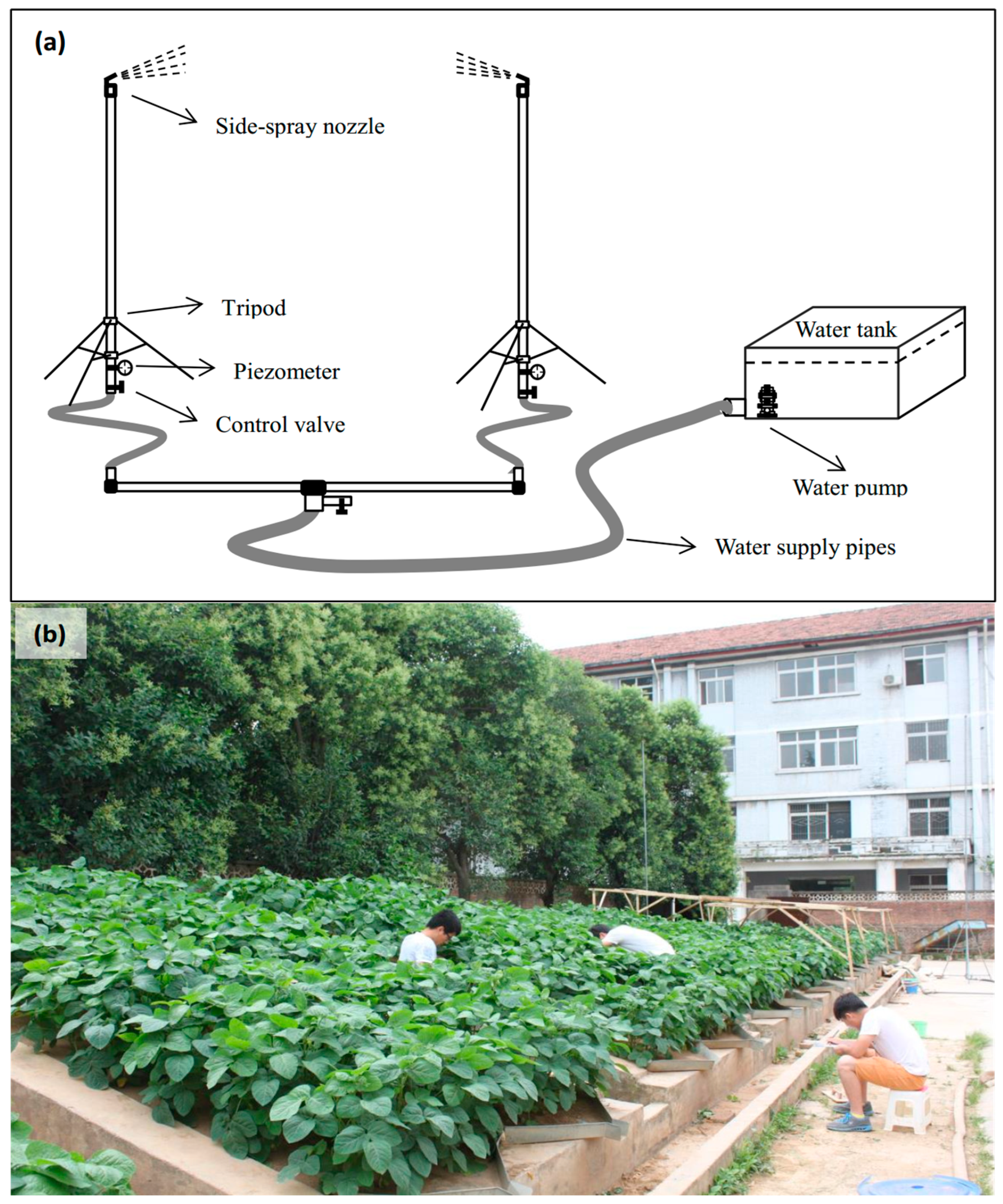
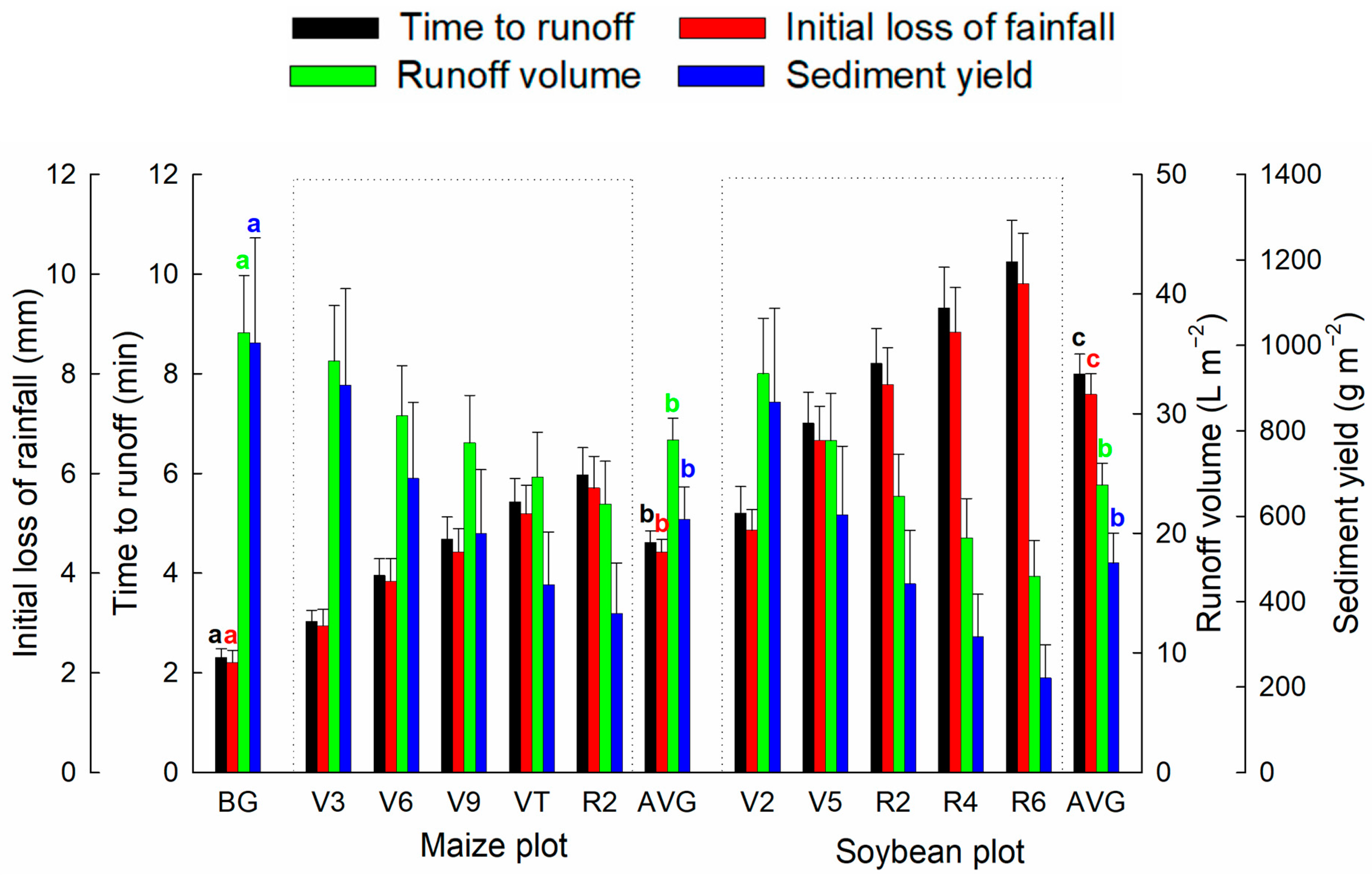
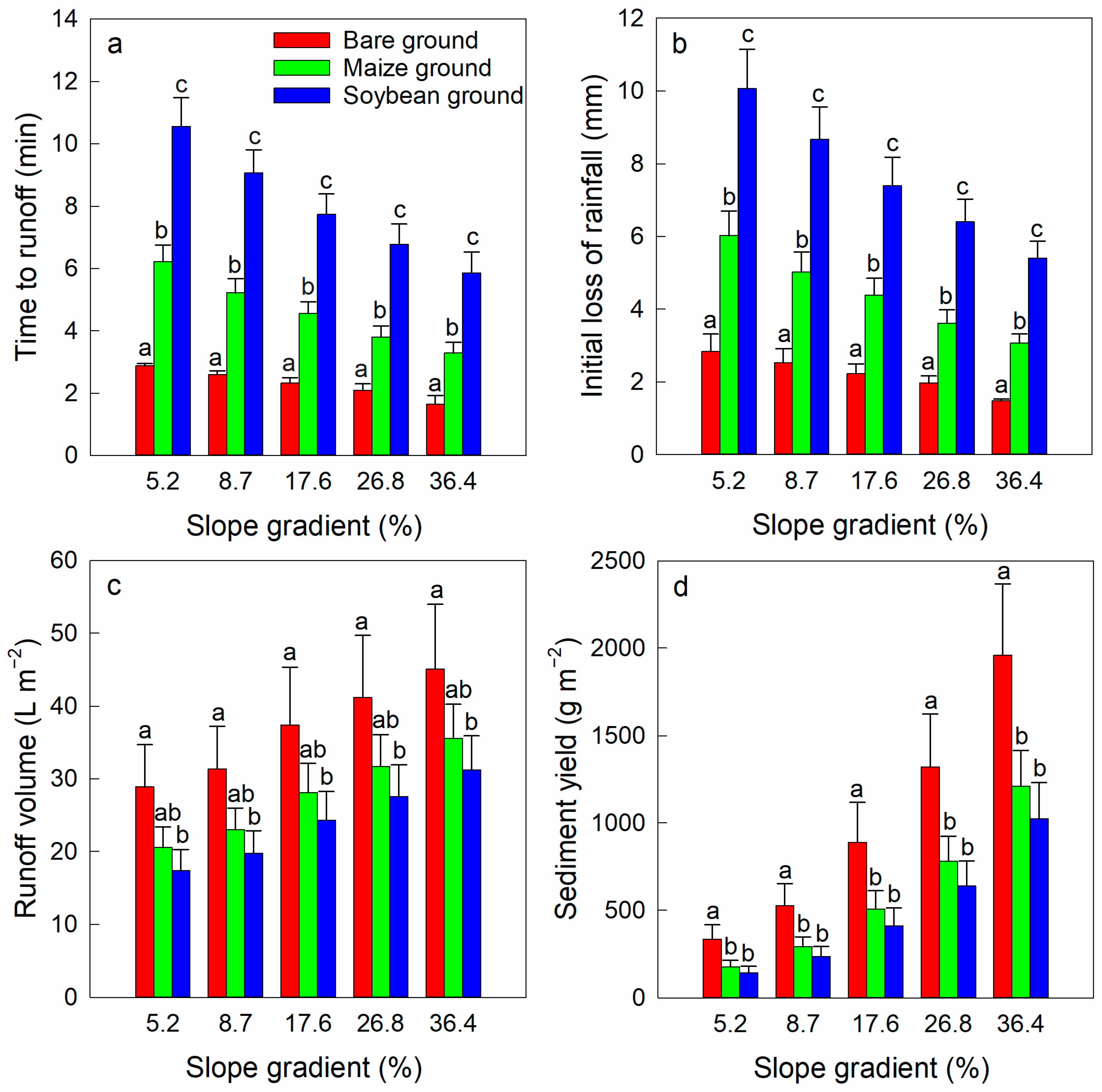
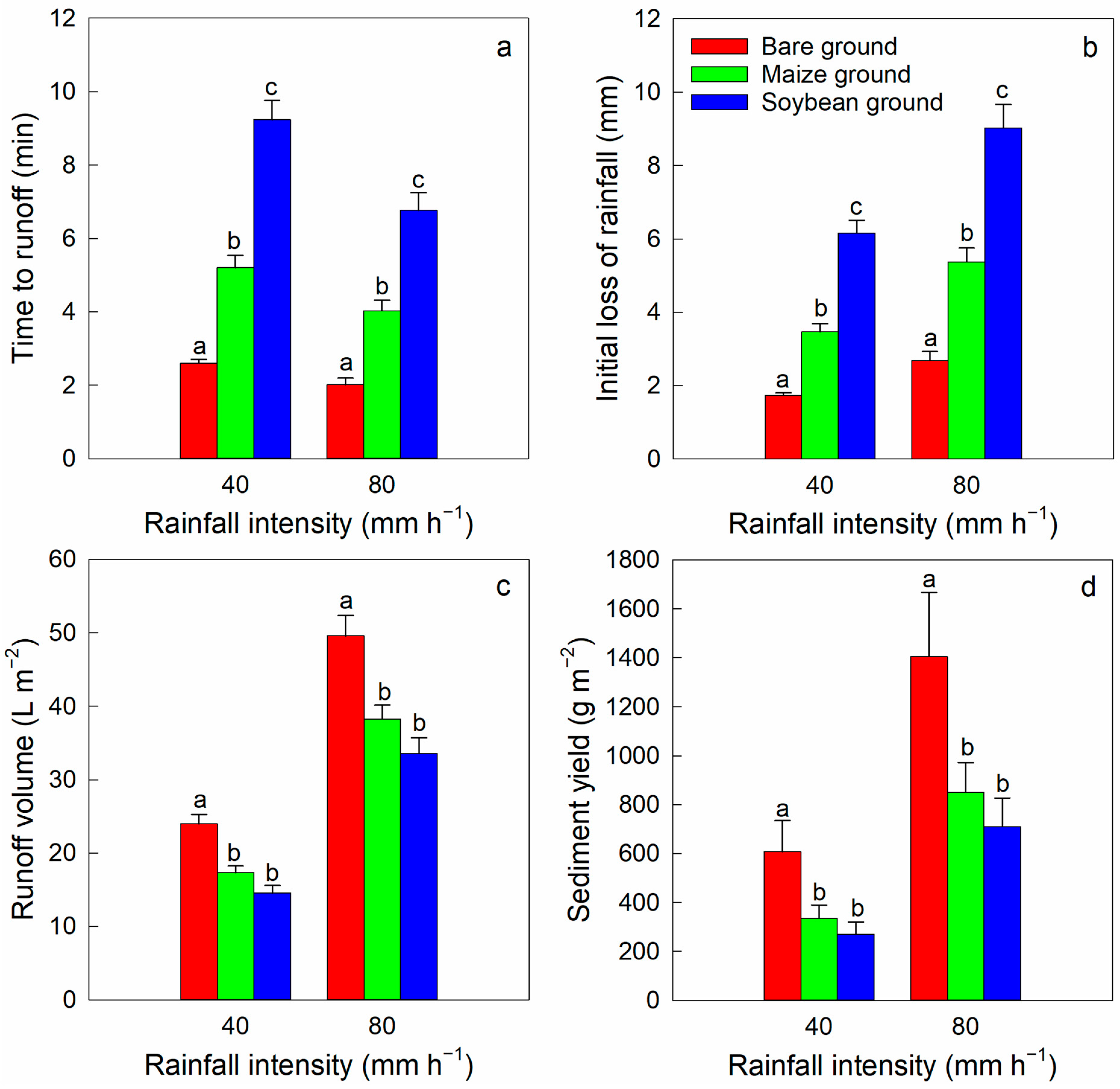
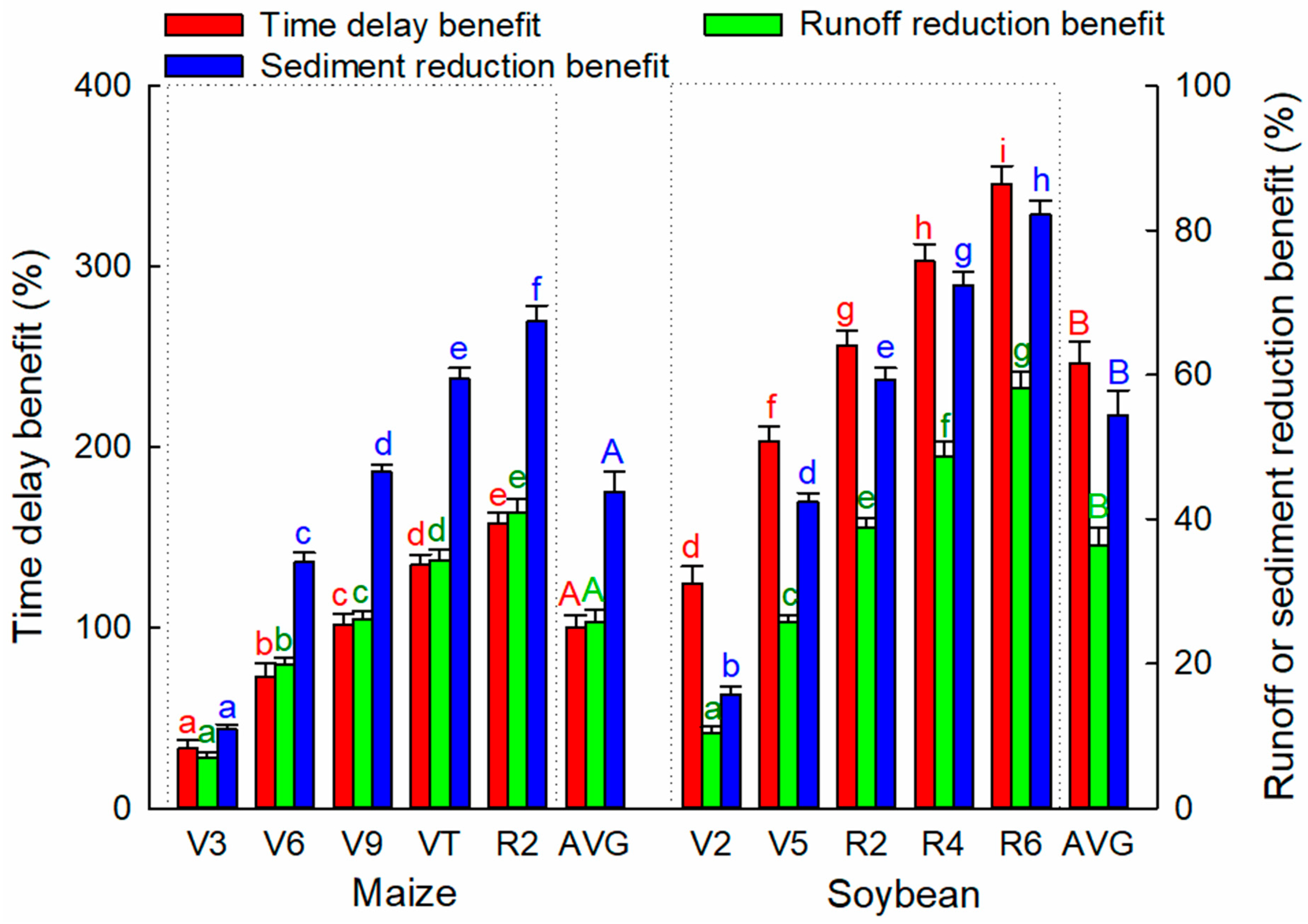
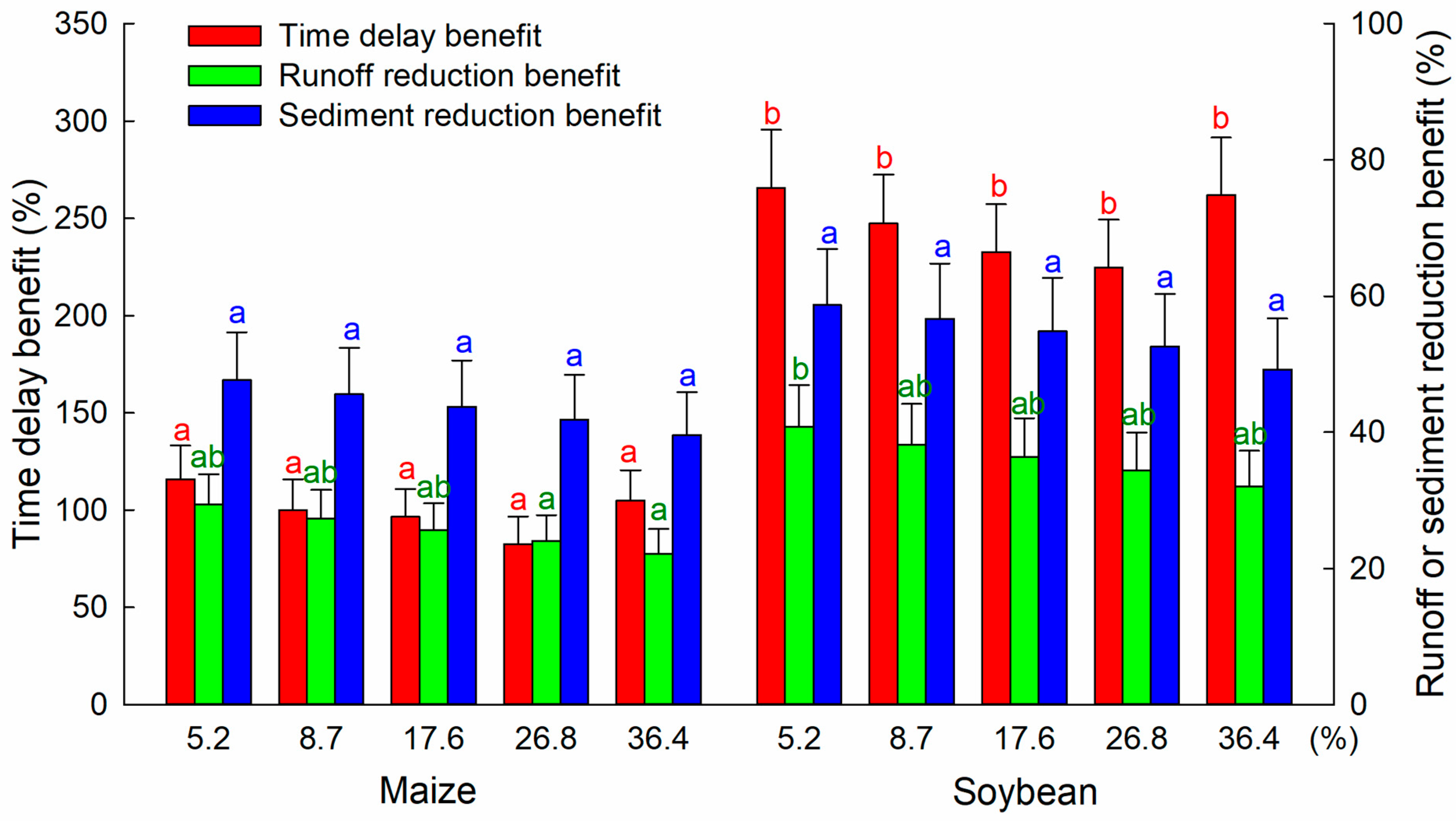



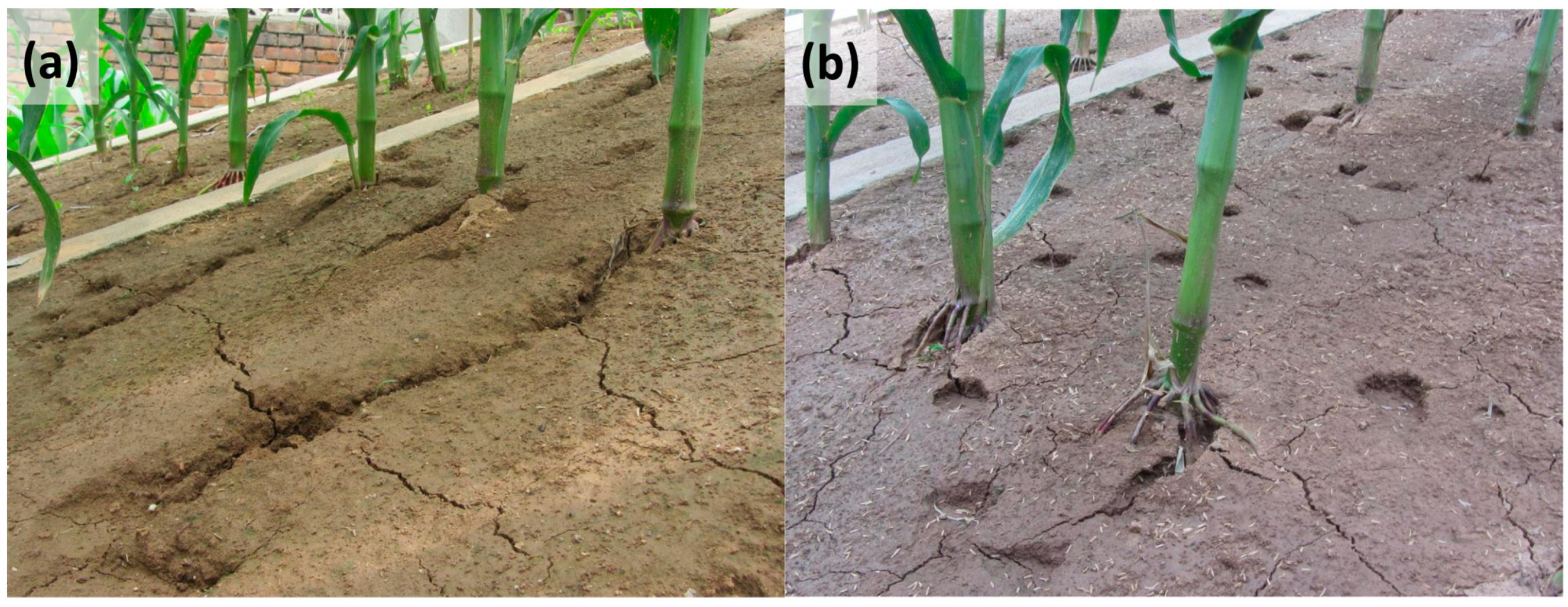
| Particle Size Distribution (%) | Texture | Porosity | SOM | TN | TP | CEC | ||
|---|---|---|---|---|---|---|---|---|
| 2–0.02 mm | 0.02–0.002 mm | <0.002 mm | (%) | (g kg−1) | (g kg−1) | (g kg−1) | (cmol kg−1) | |
| 30.0 ± 0.7 | 41.8 ± 0.5 | 28.2 ± 0.2 | Clay loam | 49.36 ± 3.70 | 13.66 ± 0.58 | 0.93 ± 0.03 | 0.54 ± 0.02 | 18.31 ± 0.86 |
| Vegetation | Growth Stage | Vegetation Coverage (%) | Date (Day/Month/Year) |
|---|---|---|---|
| Maize | Planting | 0 | 9 June 2015 |
| Emergence | - | 16 June 2015 | |
| Third leaf (V3) | 16.7 ± 1.4 | 2 July 2015 * | |
| Sixth leaf (V6) | 40.9 ± 1.6 | 14 July 2015 * | |
| Ninth leaf (V9) | 62.1 ± 1.4 | 26 July 2015 * | |
| Tasseling (VT) | 80.3 ± 2.3 | 9 August 2015 * | |
| Blister (R2) | 91.5 ± 2.0 | 2 September 2015 * | |
| Harvest | - | 2 October 2015 | |
| Soybean | Planting | 0 | 11 June 2016 |
| Emergence | - | 19 June 2016 | |
| Second trifoliolate (V2) | 20.3 ± 1.5 | 8 July 2016 * | |
| Fifth trifoliolate (V5) | 45.4 ± 1.6 | 19 July 2016 * | |
| Full bloom (R2) | 70.2 ± 1.9 | 2 August 2016 * | |
| Full pod (R4) | 86.9 ± 2.6 | 16 August 2016 * | |
| Full seed (R6) | 97.8 ± 2.1 | 1 September 2016 * | |
| Harvest | - | 5 October 2016 |
| Vegetation | Dependent Variable | n1 | n2 | n3 | m | R2 |
|---|---|---|---|---|---|---|
| Bare ground | TR | 0.000 | −0.226 | −0.335 | 16.147 | 0.847 |
| ILR | 0.000 | −0.291 | 0.674 | 0.304 | 0.911 | |
| RV | 0.000 | 0.236 | 1.049 | 0.260 | 0.998 | |
| SY | 0.000 | 0.953 | 1.172 | 0.499 | 0.991 | |
| Maize | TR | 0.423 | −0.299 | −0.361 | 7.995 | 0.961 |
| ILR | 0.402 | −0.326 | 0.641 | 0.154 | 0.961 | |
| RV | −0.208 | 0.287 | 1.141 | 0.259 | 0.988 | |
| SY | −0.415 | 1.041 | 1.287 | 0.681 | 0.979 | |
| Soybean | TR | 0.425 | −0.276 | −0.424 | 15.950 | 0.971 |
| ILR | 0.453 | −0.298 | 0.578 | 0.247 | 0.969 | |
| RV | −0.356 | 0.298 | 1.194 | 0.320 | 0.972 | |
| SY | −0.617 | 1.067 | 1.322 | 1.035 | 0.966 |
| Vegetation | Regression Equation | Standardized Regression Equation | R2 | F | p |
|---|---|---|---|---|---|
| Maize | TDB = 1.634C + 4.794 | TDB = 0.924C | 0.855 | 281.968 | p < 0.001 |
| RRB = 0.434C − 0.216S − 0.119I + 11.639 | RRB = 0.947C − 0.201S − 0.192I | 0.974 | 583.172 | p < 0.001 | |
| SRB = 0.736C − 0.242S − 0.116I + 12.352 | SRB = 0.975C − 0.137S − 0.114I | 0.983 | 894.109 | p < 0.001 | |
| Soybean | TDB = 2.736C + 71.057 | TDB = 0.939C | 0.882 | 357.894 | p < 0.001 |
| RRB = 0.598C − 0.257S − 0.173I + 13.252 | RRB = 0.957C − 0.168S − 0.197I | 0.983 | 887.377 | p < 0.001 | |
| SRB = 0.832C − 0.282S − 0.150I + 15.386 | SRB = 0.977C − 0.135S − 0.125I | 0.989 | 1356.465 | p < 0.001 |
Disclaimer/Publisher’s Note: The statements, opinions and data contained in all publications are solely those of the individual author(s) and contributor(s) and not of MDPI and/or the editor(s). MDPI and/or the editor(s) disclaim responsibility for any injury to people or property resulting from any ideas, methods, instructions or products referred to in the content. |
© 2024 by the authors. Licensee MDPI, Basel, Switzerland. This article is an open access article distributed under the terms and conditions of the Creative Commons Attribution (CC BY) license (https://creativecommons.org/licenses/by/4.0/).
Share and Cite
Xu, Q.; Lin, Q.; Wu, F. Comparative Study of the Impacts of Maize and Soybean on Soil and Water Conservation Benefits during Different Growth Stages in the Loess Plateau Region. Land 2024, 13, 1264. https://doi.org/10.3390/land13081264
Xu Q, Lin Q, Wu F. Comparative Study of the Impacts of Maize and Soybean on Soil and Water Conservation Benefits during Different Growth Stages in the Loess Plateau Region. Land. 2024; 13(8):1264. https://doi.org/10.3390/land13081264
Chicago/Turabian StyleXu, Qian, Qingtao Lin, and Faqi Wu. 2024. "Comparative Study of the Impacts of Maize and Soybean on Soil and Water Conservation Benefits during Different Growth Stages in the Loess Plateau Region" Land 13, no. 8: 1264. https://doi.org/10.3390/land13081264




